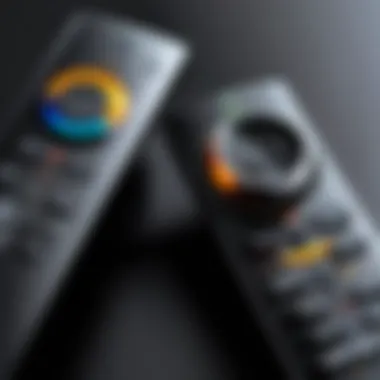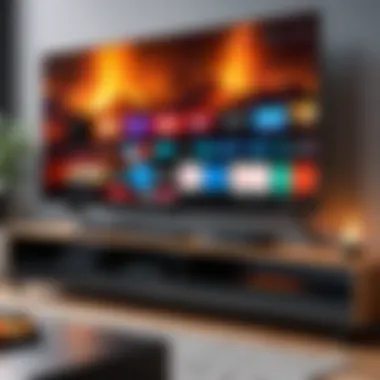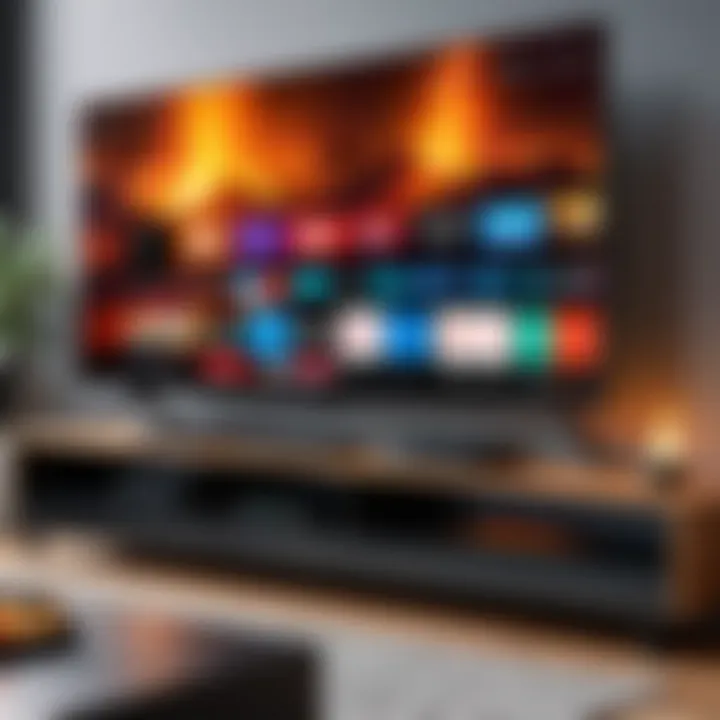Mastering Volume Control on Fire TV Devices


Intro
In today’s fast-paced digital age, having control over your home entertainment experience is more crucial than ever. As more households switch to streaming services, understanding the nuances of devices such as Amazon’s Fire TV becomes a necessity, particularly when it comes to volume control. This section serves as a primer on the multifaceted world of volume management within Fire TV devices. We’ll explore the technology behind it, and examine how you can enhance your viewing experiences while getting the most out of your device.
Overview of the Technology
When discussing Fire TV, one must first grasp the capabilities that set it apart from other streaming devices on the market. At its core, Amazon’s Fire TV is equipped with a powerful processor and ample memory, allowing for smooth performance. The volume control feature integrates seamlessly with both the device’s software and external hardware like soundbars and surround sound systems.
Key specifications
- Dolby Audio Support: The device supports audio formats such as Dolby Digital Plus, giving listeners an enhanced sound experience.
- Voice Control: With Alexa built-in, it provides hands-free volume adjustments using voice commands.
- Compatibility: Works with various audio equipment and services, making it versatile for different setups.
Unique selling points
- Customizable Volume Profiles: Users can create profiles tailored to specific content types, optimizing sound for movies, sports, or music.
- Syncing with Smart Home Devices: Fire TV can be integrated with other smart home devices for a streamlined smart living experience, controlling everything from the lights to the volume with a single command.
Design and Build Quality
Moving beyond just the technological specs, the design and ergonomics of the Fire TV remote play a significant role in user experience.
Material used
The remote is generally constructed from plastic, offering a lightweight feel while ensuring durability. The buttons are engineered for tactile feedback, a small touch that enhances usability, particularly when adjusting volume in dimly lit settings.
Ergonomics and usability
The sleek design fits comfortably in hand, making it easy to navigate even during long binge-watching sessions. The volume controls are intuitively positioned, allowing users to adjust sound levels without needing to look at the remote.
Such attention to detail in design ensures that users have a pleasant experience, which is crucial for those who might spend hours enjoying their favorite shows.
"When the volume control seamlessly integrates into your environment, it elevates the experience from ordinary to extraordinary."
Prelims to Fire TV
When you peel back the layers of technology, especially when it comes to entertainment, the importance of understanding devices like Fire TV becomes glaringly apparent. Fire TV isn't just another streaming device; it's a gateway to a universe of content, interactive experiences, and personalized viewing. Gaining insight into Fire TV's features, especially its volume control, equips users with the ability to tailor their entertainment experience, ensuring that every cinematic moment resonates with the right audio backdrop. This article’s exploration of the various volume control mechanisms and settings springs from this necessity to empower users.
Overview of Fire TV Devices
Fire TV devices come in various iterations, including Fire TV Stick, Fire TV Cube, and Fire TV Edition smart TVs. Each offers a unique set of features designed to cater to different viewing preferences. The Fire TV Stick, for instance, is compact and portable, enabling users to turn any regular HDTV into a smart TV. On the other hand, Fire TV Cube boasts hands-free voice control, merging the functionalities of a streaming device with those of a smart speaker. Users must grasp the distinctions among these devices to effectively leverage their features, including the all-important volume control.
These devices support 4K streaming, HDR, and an array of apps, making them powerhouses for media consumption. The cross-compatibility with services like Netflix, Hulu, and Prime Video means that everything you need is within a few clicks.
Importance of Volume Control
"Sound is half of the experience," many would say, echoing the essence of audio in visual storytelling. Volume control on Fire TV is not merely about turning the sound up or down; it’s about tailoring the audio to fit the context of the content. Whether it's a gripping action scene or a whispering dialogue, having the ability to adjust sound levels can significantly affect the overall enjoyment and comprehension of what you’re watching.
Moreover, the volume control mechanisms encompass various functionalities, ranging from standard remote volume buttons to sophisticated voice-activated commands. This flexibility caters to a diverse range of user preferences. For example, a quick voice command can adjust the volume while a viewer is engrossed in a show, eliminating the need to juggle the remote.
Understanding volume control also opens the door to troubleshooting and optimizing audio settings; proper adjustments can mitigate common issues such as sudden loud noises or inaudible whispers. In a world where rich auditory experiences are expected, mastering volume control is essential for every Fire TV user.
Volume Control Mechanisms
When it comes to Fire TV, understanding how to manipulate sound settings is just as crucial as knowing what to watch. Proper volume control mechanisms can significantly enhance your streaming experience, whether you’re binge-watching your favorite series or enjoying a blockbuster film. Each method serves its purpose, offering different benefits depending on individual preferences and situations.
Using the Fire TV Remote
Physical Volume Buttons


The physical volume buttons on the Fire TV remote provide a straightforward and tactile way to adjust sound levels without navigating through menus. These buttons are conveniently located, allowing for quick access when the action on screen demands immediate adjustment. The key characteristic of these buttons is their simplicity; users can easily press them without needing technical know-how. This makes them a popular choice for many users who value speed and straightforwardness.
One unique feature of the physical buttons is the linear adjustment they offer, which means you can rapidly increase or decrease volume depending on your needs at that moment. However, a potential drawback is that frequent use can wear them out over time, leading to malfunctioning buttons.
Voice Control Functionality
The voice control functionality adds a new level of convenience, allowing you to adjust the volume just by speaking commands. This capability takes advantage of Amazon’s Alexa technology, making it an attractive option for those who appreciate hands-free operation. The key characteristic here is its intuitive design; simply saying "increase the volume" or "mute the sound" can save you a lot of time.
This unique feature benefits users who are multitasking or too comfortable to fumble for the remote. However, it may not always respond as expected, particularly in noisy environments or when the microphone isn’t perfectly clear. It’s good to have alternatives at hand for such situations.
Mobile App Volume Adjustment
Features of the Fire TV App
The Fire TV app offers various features that enhance the control users have over volume settings, providing an alternative to traditional remotes. One specific aspect is the customizable interface, which allows users to adjust sound levels easily and intuitively. The app has emerged as a beneficial choice for tech-savvy individuals who like having more options at their fingertips.
A unique feature worth noting is the ability to control TV settings from anywhere in the house, making it easier to adjust volume without being right in front of the screen. The downside, however, is the requirement for an additional device, which could deter those not keen on installing apps on their phones.
Connecting Your Mobile Device
Connecting your mobile device to Fire TV allows for seamless volume adjustments through the app. This functionality offers a modern twist on the traditional remote by introducing a more personalized approach to controlling sound. The key characteristic is that it enables users to manage their devices remotely, which many find highly appealing.
One unique aspect of this connection is the ability to utilize the mobile device’s features – like voice recognition and advanced touchscreen controls – to manipulate volume. However, this method may require an initial setup that could be problematic for some users, especially those less comfortable with technology.
The diversity of volume control options available on Fire TV means users can choose what works best for them, whether it's by buttons, voice, or mobile devices.
In summary, understanding these volume control mechanisms – from the reliable physical buttons to the convenience of mobile apps – is essential for anyone looking to optimize their Fire TV experience. Each method has its advantages and potential downsides, but being aware of all these options allows for a more tailored viewing experience.
Volume Control Settings
Navigating the audio landscape of Fire TV devices isn't just about controlling the sound levels; it's a gateway to a more immersive viewing experience. Understanding the volume control settings can significantly enhance how users interact with their content, whether it's a gripping drama, a documentary, or an exhilarating action movie. The right setup can make you feel the rumble of an explosion or hear every whisper in a conversation. Let's delve into this crucial aspect, which can often be overlooked amidst the flashy interface of modern smart TVs.
Accessing Audio Settings
The initial step towards mastering volume control is to access the audio settings. Users can find these settings easily through their Fire TV's main menu. It's not buried deep in submenus; instead, it's just a few clicks away. By navigating to the settings icon, selecting "Preferences", and then choosing "Audio" options, you open up a world of sound customization.
Adjusting these settings allows one to tailor their audio experience. Whether it’s optimizing volume levels for different content types or changing output settings, getting to grips with audio settings ensures that you never miss a beat, literally. This ability to tweak sound can turn a viewer's home into their own private cinema.
Adjusting Volume Levels
Finding the right volume levels is essential for enjoying your Fire TV. But it involves more than simply cranking the volume knob or pushing the buttons up and down. Smart volume adjustment means understanding the options available.
Audio Output Options
One key consideration in volume control settings is the audio output options. This feature embodies the versatility of Fire TV. Users can switch between the device’s built-in speakers, a connected soundbar, or even a home theater system with just a few clicks.
The standout characteristic of audio output options is its adaptability. Users can pick whatever suits their setup. The flexibility it offers is a significant advantage, especially for folks who might have invested in high-quality surround sound systems. However, while convenient, it also has a downside—sometimes, switching outputs can result in delayed audio, especially if using Bluetooth devices. Still, for many users, the pros outweigh the cons, making it a popular choice.
Volume Normalization
Another essential feature to explore is volume normalization. This functionality adjusts the volume for varying content levels. Ever watched a movie and had to jump to adjust the sound between scenes? Volume normalization helps mitigate this annoyance.
The primary benefit of volume normalization lies in its ability to provide a consistently pleasant listening experience. It levels the highs and lows so that soft scenes don't disappear into the background noise while ensuring louder moments don't blast the ears. While this feature greatly improves the overall viewing experience, some users might find that it can sometimes dampen the zest of a particularly lively soundtrack. However, most will discover that the trade-off is worth enjoying uninterrupted content.
"In the realm of media consumption, sound isn't just an accessory; it's a part of the narrative. Mastering volume settings can transform your viewing experience from mundane to breathtaking."
By understanding and leveraging the capabilities of volume control settings on their Fire TV, users can fine-tune their experience. The key takeaway here is that adjusting these components helps each viewer create the perfect atmosphere for enjoying their favorite shows and movies.
Troubleshooting Common Volume Issues


When using Fire TV, users may encounter a few hiccups with volume control. Addressing these problems is essential for a smooth viewing experience. This section digs into the most common volume issues and provides insights into practical solutions. It's not just about catching up on your favorite shows; it’s also about ensuring you hear every whisper and explosion without any frustration.
Loudness Fluctuations
Causes of Volume Inconsistency
Volume inconsistency can be a real pain in the neck. Often, this issue stems from various sources within the device or external audio setup. One of the primary culprits is the audio format of the content being played. For instance, streaming a movie in 5.1 surround sound through certain sound systems might lead to erratic volume levels.
Another significant factor is the streaming app itself. Some services adjust sound levels dynamically, which can lead to unexpected loudness shifts during playback. Recognizing these inconsistencies is vital as it directly impacts viewer satisfaction.
- Key Characteristic: Fluctuation during different content types.
- Benefits: Understanding the cause can help users modify their approach, ensuring a more uniform sound experience.
Adjusting Settings for Stability
Stabilizing volume settings can often tame those loudness fluctuations. Within the Fire TV settings, you’ll find options that allow tight control over audio levels. For example, enabling Volume Normalization can even out the sound during playback. This feature ensures no abrupt jumps in loudness, making binge-watching less about reaching for the remote.
Additionally, configuring sound bars or receivers to output a consistent level can help. Connecting via HDMI-CEC can allow the Fire TV to control the volume settings of other devices, leading to a more cohesive audio experience. However, the downside here is that this requires some setup knowledge which might be confusing for certain users.
- Key Characteristic: Helps achieve uniform sound levels across different types of media.
- Benefits: Maintains viewer comfort, making it easier to enjoy long viewing sessions without irritating adjustments.
No Sound Output
Diagnosing the Problem
It’s quite vexing when your device just decides to go mute on you. Diagnosing sound output issues is the first step in getting audio back. Users should check both the Fire TV settings and their television’s audio settings. This double-check helps ensure the problem isn't stemming from mismatched settings.
A common oversight is simply ensuring that the Fire TV is selected as the audio output device. In some cases, connecting cables can go loose or become damaged, which can lead to audio failure.
- Key Characteristic: Identification of the source can be streamlined with simple checks.
- Benefits: Quick identification often leads to easy fixes without needing professional intervention.
Step-by-Step Resolution
Resolving sound issues can be straightforward if you follow a methodical approach. Here’s a step-by-step guide:
- Check Your Connections: Ensure that cables plugged into your device are secure.
- Inspect Sound Settings: Go to Fire TV settings and check the audio output options.
- Test Different Content: Try playing various shows or movies to see if the problem persists.
- Power Cycle Devices: Sometimes a simple restart can resolve odd glitches.
While this may seem simple, it addresses a lot of hiccups users might face. Making these adjustments can restore sound efficiently and help users get back to enjoying their programming.
- Key Characteristic: Analytical approach tailored for user accessibility.
- Benefits: Users can self-resolve issues rather than relying on customer support, saving time and frustration.
Integration with External Audio Devices
In today’s digital age, sound quality can make or break your viewing experience. Smart devices like Fire TV offer an array of options to connect with external audio devices, ranging from soundbars to top-notch speakers. Integration with these audio systems is not merely an upgrade; it's about crafting a immersive atmosphere that can transform a simple movie night into a cinematic adventure. Let’s delve into the significance and benefits of maximizing this capability.
Enhancing audio quality is crucial when watching movies or listening to music. While Fire TV provides a decent built-in speaker experience, there’s a vast world out there when it comes to external audio connections. Using external audio devices like soundbars or home theater systems can improve clarity, depth, and range. The richness of sound adds layers to the viewing experience, drawing you deeper into the narrative arc of your favorite shows. However, it is essential to understand the setup process and ensure compatibility to reap these benefits.
Connecting Soundbars and Speakers
Connecting your Fire TV to soundbars and speakers can enhance the overall audio quality significantly. This can be done in a few different ways, and understanding how each method works is key to making the right choice.
- Bluetooth Connection: One of the sleekest methods of linking your Fire TV to external speakers is via Bluetooth. This method is straightforward and helps eliminate the wires that can clutter your setup. Just ensure your soundbar is in pairing mode and follow the instructions on your Fire TV to connect. However, keep in mind potential latency issues that can occasionally arise with Bluetooth devices, which might lead to a slight sync issue between audio and video.
- Optical Audio Connection: If your soundbar has an optical input, connecting via a digital optical cable can improve sound quality through faster data transfer, reducing lag time. Simply connect one end of the cable to your Fire TV’s optical out port and the other to your soundbar.
- HDMI Connection: Many modern soundbars come equipped with HDMI ARC (Audio Return Channel). This option allows you to control both the TV and the soundbar with a single remote, which simplifies your remote control situation. Additionally, HDMI often supports higher quality sound formats, providing a better audio experience.
Connecting these devices not only elevates sound quality but also enhances overall user convenience. Users should always check their sound systems’ compatibility with Fire TV to avoid wasting time and effort.
Utilizing HDMI-CEC
Understanding HDMI-CEC


HDMI-CEC, or Consumer Electronics Control, is a feature that's been quietly revolutionizing how we interact with our home entertainment systems. This protocol allows multiple devices connected through HDMI to control each other seamlessly. For instance, you can turn your Fire TV on or off using the TV remote, and the soundbar can be adjusted with the same remote. This interconnectedness is enormously beneficial for simplifying the viewer’s experience.
A standout characteristic of HDMI-CEC is its capability to reduce the number of remotes you need to juggle. Imagine settling down for a movie, not having to sift through a pile of remotes just to turn on the speaker or adjust the volume. A convenient setup goes a long way in creating a frictionless entertainment experience.
However, a notable disadvantage can be the inconsistency in functionality across different brands. Users may find that not all features work as expected, or some devices may not respond to the control commands. It’s advisable to consult product manuals or manufacturers' websites for guidance on the compatibility of HDMI-CEC features.
Enabling Control Features
Enabling control features through HDMI-CEC can further enhance the user experience. Most Fire TVs have HDMI-CEC enabled by default, but it may require a little tweaking within the settings menu. Once it’s properly set up, controlling multiple devices becomes a breeze.
A critical aspect of this feature is the ability to switch between devices without the hassle of constantly adjusting settings. If you're transitioning from watching a show to listening to music, being able to seamlessly transfer control can elevate your viewing and listening enjoyment. Furthermore, you can manipulate other features like power settings and audio output without additional steps, streamlining your entire setup.
However, while it may be comic relief for some tech enthusiasts, occasional glitches can occur. Discrepancies between devices may crop up, leading to confusion as to which remote should be used or which function actually works, especially with older hardware. Therefore, it's wise to test connectivity and control features when setting up your system and keep the user manuals handy for troubleshooting tips.
Advanced Audio Features
When it comes to enjoying content on Fire TV, Advanced Audio Features stand as the crown jewel, amplifying the audiovisual experience far beyond what standard settings can offer. These features are not just fancy add-ons; they play a crucial role in shaping how users perceive sound, thereby enriching the viewing experience. Today’s technology-savvy audience seeks not just visual stimulation but immersive sound, making these features significant in the overall crafting of entertainment.
Dolby Digital and Surround Sound
Setup Requirements
Diving into the setup requirements for Dolby Digital and Surround Sound is like assembling a jigsaw puzzle. A proper installation involves a couple of elements being just right. First off, you need a compatible Fire TV device—many of the newer models already come equipped. Then, your TV or receiver must support Dolby Digital, which is usually stated in the specs or manual. The neat trick here is finding the right cables; most often, an HDMI connection does the job.
This particular setup is beneficial for those who are in pursuit of fantastic sound quality. Users often find that HDMI ARC (Audio Return Channel) provides a seamless connection that makes controlling audio a breeze. However, one unique feature here is the ability for these setups to handle multiple audio channels simultaneously, letting you experience sound as you would in a cinema. But it’s a bit nuanced—if you have an older TV, it may not support these surround sound formats, and that could dampen the experience.
Enhancing the Viewing Experience
Enhancing the viewing experience with Surround Sound is akin to upgrading from a bicycle to a motorcycle—everything feels faster and more engaging. The key characteristic here is that Surround Sound allows for multi-dimensional audio, which immerses the viewer in the action, making them feel like they are part of it rather than just an observer. Sounds zoom past, and the ambiance envelops you.
The unique feature is how Surround Sound can adjust dynamically based on what’s happening on screen. For instance, during an action scene, the sound may seem to swirl around you, while in quieter moments, it settles into the background gently. This dynamic response is a significant advantage, recreating a theatre-like experience right in your living room. However, one might face a drawback—setting it up can require some trial-and-error, especially for fine-tuning, which may not be everyone’s cup of tea.
Closed Captioning and Accessibility Options
Configuring Closed Captions
Configuring Closed Captions is an essential aspect of making content accessible. Especially for individuals who are hard of hearing or for those who prefer to follow along with the text while watching, closed captions play a significant role in enhancing the viewing experience. The process is simple yet profound; from the Fire TV Settings menu, you can toggle captions on and off easily with a few clicks.
What makes this option compelling is the ability to customize captions in terms of font size and color. This adaptability caters to personal preferences, ensuring viewers can engage with the content comfortably. A potential downside may arise if the captions are too verbose, cluttering the screen and detracting from the visual elements of a film or show.
Accessibility Settings Overview
When delving into Accessibility Settings, it’s like opening a treasure chest of features designed to empower viewers. This section provides tools such as voice guidance, text enlargements, and additional caption controls. By including this level of detail, Fire TV ensures that people with different needs can enjoy all kinds of content without a hitch.
One stellar aspect of Accessibility Settings is the VoiceView feature, allowing for a spoken description of the screen. This is especially beneficial for those who rely on audio cues. On the flip side, the settings can appear daunting at first glance due to a multitude of options, which might confuse some users. Yet, once navigated successfully, they open up an enriched viewing world.
"Accessibility features are not just enhancements; they fundamentally change how individuals experience media, promoting inclusivity and engagement."
End
In the realm of Fire TV devices, understanding how to navigate volume control is paramount for ensuring an optimal viewing experience. The myriad of features discussed throughout this article highlight just how crucial effective volume management is, not only for comfort but also for sound quality. When you have a firm grasp of the volume control mechanisms, you open a door to seamless entertainment. Whether it's tweaking settings for clarity or engaging advanced features like Dolby Digital and surround sound, every adjustment can elevate your viewing experience significantly.
Recap of Volume Control Features
To summarize, the volume control features on Fire TV encompass a range of methods to cater to different preferences:
- Using the Fire TV Remote: Physical buttons offer quick adjustments, while voice control can facilitate hands-free operation.
- Mobile App Volume Adjustment: The Fire TV app allows for convenient sound management from your smartphone, providing a sleek interface and easy navigation.
- Settings Access: The ability to delve into audio settings gives users control over audio output options, which can dramatically impact sound fidelity.
- Troubleshooting Issues: Knowing how to address loudness fluctuations and complete silent outputs can save time and frustration, ensuring that your entertainment stays uninterrupted.
- Integration with Audio Devices: Connecting soundbars or utilizing HDMI-CEC enables users to create a tailored audio environment, further enhancing the overall experience.
Future Developments in Fire TV Technology
As we look forward, the landscape of Fire TV technology continues to evolve. With rapid advancements on the horizon, several areas show promise for enhancing volume control:
- Enhanced Smart Features: Anticipate breakthroughs in artificial intelligence that might automatically adjust volume based on ambient noise levels or content type. This could mean movie nights become perfectly tuned without any user intervention.
- Greater Device Compatibility: The growing trend toward IoT could see Fire TV work seamlessly with a wider assortment of smart home devices, optimizing audio experiences throughout your living space.
- Refined Audio Processing: Ongoing developments in sound processing technologies may enhance the overall clarity and depth of sound, allowing users to enjoy a cinema-like experience at home.
Staying up-to-date with these trends can help users maximize the functionalities of their Fire TV and ensure they are prepared for what's next in home entertainment tech.







